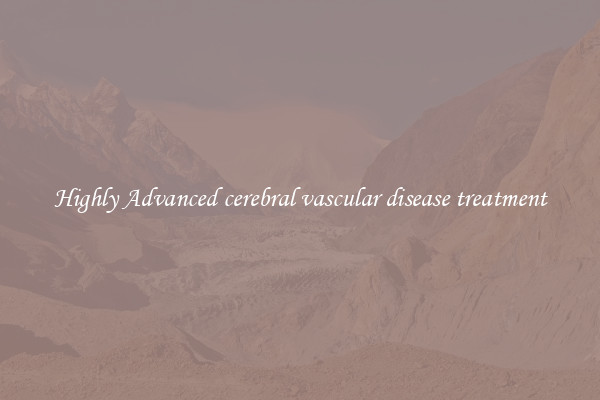Highly Advanced cerebral vascular disease treatment
Highly Advanced Cerebral Vascular Disease Treatment: Revolutionizing Care

Cerebral vascular disease, also known as cerebrovascular disease, is a condition that affects the blood vessels that supply oxygen and nutrients to the brain. It encompasses a wide range of disorders, including stroke, transient ischemic attack (TIA), and vascular dementia. These diseases can have severe consequences, causing disabilities or even death. However, with the development of highly advanced treatments, there is hope for better outcomes and improved quality of life.
One of the groundbreaking advancements in the treatment of cerebral vascular disease is the use of minimally invasive procedures. Traditional treatments often involved open surgery, with lengthy recovery times and significant risks. However, with the advent of techniques such as endovascular therapy, neurosurgeons can now access the affected blood vessels through small incisions and navigate specialized tools to remove clots or repair ruptures. This approach not only reduces complications but also accelerates recovery times, allowing patients to return to their normal activities sooner.
Another revolutionary treatment option that has gained prominence is neurointerventional radiology (NIR). This specialty combines the expertise of neurology and radiology to provide precise and targeted treatments for cerebral vascular disease. With NIR, doctors can visualize the blood vessels in real-time using advanced imaging techniques and, if necessary, perform interventions immediately. This includes procedures such as stent placement, angioplasty, and coil embolization, which help restore blood flow to the brain, stabilize weakened blood vessels, and prevent further damage.
In recent years, the field of regenerative medicine has also shown promise in advancing cerebral vascular disease treatment. Stem cell therapy, a form of regenerative medicine, involves the use of undifferentiated cells that can differentiate into various cell types, including those found in blood vessels. Researchers are exploring the potential of utilizing stem cells to repair damaged blood vessels, stimulate the growth of new vessels, and improve the overall function of the brain. While this field is still in its early stages, the results so far have been encouraging, offering a glimpse into the future of personalized and regenerative treatments.
Furthermore, advancements in technology have enabled the development of cutting-edge diagnostic tools for cerebral vascular disease. Advanced imaging techniques, such as magnetic resonance imaging (MRI) and computed tomography (CT) scans, allow doctors to visualize the brain and blood vessels in high resolution, aiding in accurate diagnosis and treatment planning. Additionally, artificial intelligence (AI) algorithms are being developed to analyze these images, providing clinicians with valuable insights and facilitating more precise treatment decisions.
In conclusion, highly advanced treatments for cerebral vascular disease are changing the landscape of patient care. Minimally invasive procedures, neurointerventional radiology, regenerative medicine, and state-of-the-art diagnostic tools have revolutionized the way we approach these conditions. These advancements hold the promise of improved outcomes, shorter recovery times, and enhanced quality of life for patients. With ongoing research and innovation, the future looks bright for individuals affected by cerebral vascular disease.

View details

View details

View details

View details








